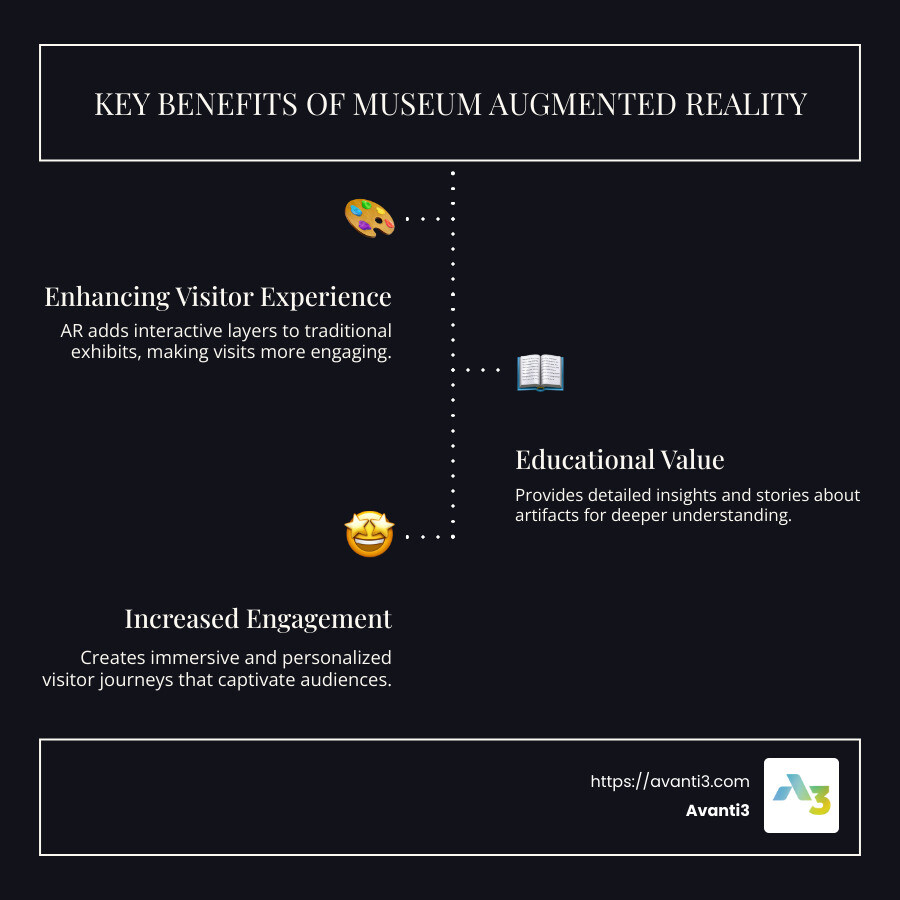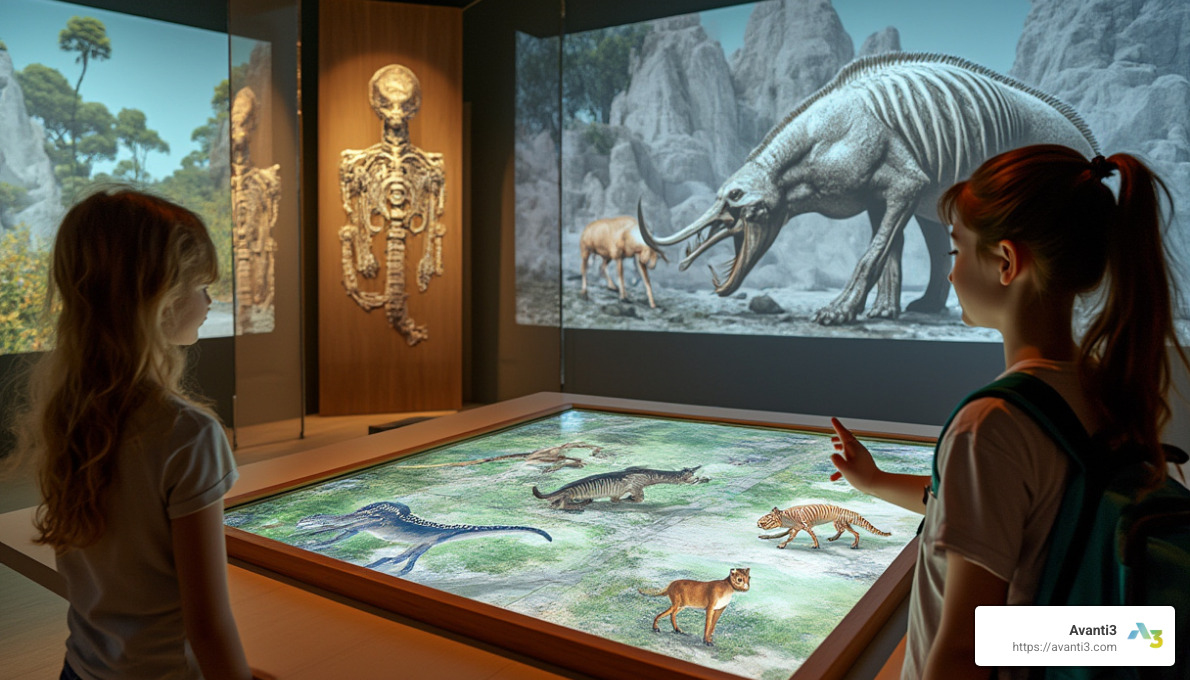Museum augmented reality is changing cultural experiences by bringing art and history to life like never before. In recent years, museums worldwide have started using augmented reality (AR) to enrich the visitor experience, offering interactive, educational, and engaging encounters with exhibits. Whether it’s guiding visitors through busy streets straight to a museum’s entrance, like the Sunshine Aquarium’s penguin guides in Tokyo, or providing deeper insights into Salvador Dalí’s Masterworks, AR revolutionizes how we interact with cultural artifacts.
- Enhancing Visitor Experience: AR adds interactive layers to traditional exhibits.
- Educational Value: Offers detailed insights and stories about artifacts.
- Increased Engagement: Creates immersive and personalized visitor journeys.
I’m Samir ElKamouny AV, a digital entrepreneur with a focus on leveraging technology to improve user experiences. My work has helped transform many businesses, and I have a deep passion for utilizing museum augmented reality to innovate cultural engagement. Let’s dig deeper into how AR is elevating museum interactions.

The Rise of Augmented Reality in Museums
Augmented reality (AR) is rapidly becoming a game-changer in the museum world. By overlaying digital information onto the physical world, AR technology is enhancing visitor engagement and creating dynamic digital experiences that captivate audiences of all ages.
AR Technology: A New Frontier for Museums
Museums are embracing AR to offer visitors something extraordinary. AR technology allows museums to display virtual elements alongside real-world exhibits, providing a richer narrative and deeper understanding of cultural artifacts. This technology is not just about adding digital layers but creating an interactive space where history and art come alive.
For example, the National Gallery in London brought classic paintings to life on the streets, allowing people to experience art outside the museum’s walls. Visitors could use their phones to see works by artists like Vincent Van Gogh and Titian in the busy city environment.
Engaging Visitors Like Never Before
AR in museums transforms passive viewing into active participation. Visitors become part of the story, interacting directly with exhibits. This engagement is not only entertaining but also educational.
Take the Smithsonian Institution’s Bone Hall, where an AR app called “Skin and Bone” allows visitors to see skeletons in a new light. The app overlays images of muscles and skin onto the bones, showing how these creatures might have looked and moved in real life. This interactive experience deepens understanding and sparks curiosity.
Creating Memorable Digital Experiences
AR provides museums with the tools to craft memorable digital experiences that visitors won’t forget. By blending the physical and digital worlds, museums can tell stories in innovative ways.
The National Museum of Singapore’s Story of the Forest is a stellar example. This immersive installation uses AR to animate natural history drawings, allowing visitors to “catch” and learn about various species. It’s a family-friendly experience that turns learning into an trip.
In summary, museum augmented reality is not just a trend; it’s a transformative force that is reshaping how we experience culture. By engaging visitors with interactive and educational content, museums are forging deeper connections with their audiences and offering unique, personalized journeys through art and history.
Innovative AR Museum Exhibits
Augmented reality is transforming museum exhibits into interactive journeys, allowing visitors to engage with art and history like never before. Let’s explore some standout examples of museum augmented reality that are setting new standards for immersive experiences.
Avanti3 Museum: Visions of Nature
The Avanti3 Museum has taken a bold step into the future with its Visions of Nature exhibition. This mixed-reality experience, launched in collaboration with Microsoft and Saola Studio, transports visitors to the year 2125. Using Microsoft HoloLens 2 headsets, guests encounter interactive holographic animations of species like cuttlefish and Darwin’s frog, alongside stunning landscapes like the Scottish Highlands.
A key feature is Hope, a scientific copilot guiding visitors through each scene. This narrative-driven approach not only captivates but also educates, highlighting the potential impacts of human actions on ecosystems. It’s part of Avanti3’s initiative to inspire proactive change regarding environmental issues.

Avanti3 Gallery: Art Beyond Walls
The Avanti3 Gallery has creatively extended its reach beyond the museum walls. By using AR technology, the gallery brought classic paintings to life on the streets. Visitors could use their smartphones to view masterpieces by artists such as Vincent Van Gogh and Titian, set against the vibrant backdrop of the city. This initiative not only made art more accessible but also integrated cultural experiences into everyday life.
Story of the Forest: Avanti3 Museum
At the Avanti3 Museum, the Story of the Forest exhibit is a captivating blend of art and technology. This immersive installation uses AR to animate natural history drawings, changing them into lively, interactive scenes. Visitors can “catch” digital representations of various species, turning the museum visit into an educational game. This approach not only engages younger audiences but also improves learning through play.

AR: A Transformative Tool for Museums
These examples illustrate how museum augmented reality is revolutionizing the visitor experience. By integrating digital elements with physical exhibits, museums are crafting unforgettable journeys that educate and entertain. The use of AR in museums is not just a fleeting trend; it’s a powerful tool that is reshaping how we connect with art and history, making cultural experiences more interactive and accessible for everyone.
Museum Augmented Reality: Enhancing Visitor Experience
Augmented reality (AR) is making museum visits more exciting and educational. It turns static displays into dynamic experiences, engaging visitors in new ways. Let’s look at how museum augmented reality is enhancing the visitor experience through interactive installations, educational tools, and immersive storytelling.
Interactive Installations
Interactive installations are changing how visitors engage with museum exhibits. One standout example is the Skin and Bone app at the Smithsonian Institution in Washington, DC. This AR app brings skeletons to life by overlaying images of muscles and skin, showing how these animals would have moved. Visitors can watch a vampire bat take flight or see an anhinga fish, providing a unique glimpse into the past.
The Natural History Museum of Los Angeles County also uses AR to drive interaction. By scanning posters throughout the city, visitors can open up 3D experiences and even take photos with a T. Rex. These installations make learning fun and memorable, encouraging exploration and discovery.
Educational Tools
AR is a powerful educational tool in museums. It allows visitors to explore exhibits in-depth at their own pace. For example, the Story of the Forest exhibition at the National Museum of Singapore uses AR to transform natural history drawings into interactive scenes. Visitors can “catch” digital animals and plants, adding them to a virtual collection where they learn about each species’ habitat and diet.
This gamified approach not only educates but also captivates younger audiences, making learning an enjoyable trip. It turns museum visits into interactive lessons that encourage curiosity and exploration.
Immersive Storytelling
Immersive storytelling is another way AR is enhancing museum experiences. The Visions of Nature exhibit at the Natural History Museum in London uses AR to transport visitors to the year 2125. With the help of holographic animations and a scientific copilot named Hope, visitors explore future ecosystems and understand the impact of human actions on the environment.
This narrative-driven approach engages visitors on a deeper level, making the information more relatable and impactful. It transforms museum visits into stories where visitors are active participants, rather than passive observers.
By integrating museum augmented reality into exhibits, museums are creating more engaging and educational experiences. AR is not just a tool for entertainment; it’s a bridge that connects visitors with art, history, and science in meaningful ways. As we continue to explore the possibilities of AR, museums will become even more interactive and accessible, inviting everyone to start on these incredible journeys.
Top Examples of AR in Museums
Augmented reality is changing museums worldwide, making visits more engaging and educational. Let’s explore how some museums are leading the way with innovative museum augmented reality experiences.
Dalí Museum
The Dalí Museum in St. Petersburg, Florida, is home to one of the most acclaimed collections of Salvador Dalí’s works. They use AR to bring Dalí’s “Masterworks” to life. Visitors can scan a QR code next to select paintings, watching as the art comes alive with animations and additional information. This immersive experience helps visitors understand the deeper meanings behind Dalí’s monumental pieces, making art appreciation more interactive and memorable.
Smithsonian Institution
The Smithsonian Institution in Washington, DC, offers a fascinating AR experience with their Skin and Bone app. This app animates skeletons in their Bone Hall, some of which have been on display since 1881. By overlaying images of muscles and skin, visitors can see how these animals would have moved. It’s a unique way to connect with history, as visitors can watch a vampire bat take flight or see an anhinga fish in action.
Pérez Art Museum
The Pérez Art Museum in Miami is another excellent example of AR in action. They use the technology to improve their contemporary art exhibits, providing visitors with layers of information and context. Through AR apps, visitors can access artist interviews, behind-the-scenes footage, and interactive elements that deepen their understanding of the artworks on display. This approach not only enriches the viewing experience but also fosters a deeper connection between art and audience.
Art Gallery of Ontario
The Art Gallery of Ontario in Toronto partnered with digital artist Alex Mayhew to create the ReBlink AR installation. This project reimagines existing artworks by transporting them into the 21st century. Using a phone or tablet, visitors can see classic paintings come alive with modern twists. For example, a serene scene of characters playing a game is transformed into a busy cityscape with each character absorbed in their own smartphone. This creative use of AR challenges visitors to think about the impact of technology on our lives and encourages them to engage with art in a new way.
These examples demonstrate how museum augmented reality can transform traditional exhibits into dynamic, engaging experiences. By integrating AR, museums are not only preserving history and art but also making them accessible and exciting for today’s tech-savvy audiences.
Frequently Asked Questions about Museum Augmented Reality
How does augmented reality improve museum exhibits?
Augmented reality (AR) enhances museum exhibits by making them more interactive and educational. Visitors can engage with content in innovative ways, such as through interactive installations and immersive storytelling. For instance, AR can overlay digital information on physical exhibits, providing detailed insights and historical context that enrich the visitor experience. This technology makes learning fun and accessible, transforming a simple museum visit into a memorable and educational journey.
What are some examples of museums using AR technology?
Several museums are leading the way in using AR technology to enhance visitor experiences. The Dalí Museum in St. Petersburg, Florida, uses AR to animate Salvador Dalí’s “Masterworks,” offering visitors a deeper understanding of the art through dynamic animations and information accessible via QR codes.
The National Gallery is another prime example, where AR is used to bring paintings to life, adding layers of context and encouraging visitors to explore art from new perspectives. These museums highlight how museum augmented reality can transform traditional exhibits into interactive experiences that captivate audiences.
How can visitors access AR experiences in museums?
Accessing AR experiences in museums is often straightforward and user-friendly. Many museums provide AR apps that visitors can download on their smartphones. These apps often use QR codes placed next to exhibits, which visitors can scan to open up AR content. By simply pointing their phone’s camera at the QR code, visitors can view animations, videos, and other multimedia content that improve their understanding and enjoyment of the exhibits.
This seamless integration of technology allows visitors to explore museums in a personalized and interactive way, making the most of their visit by engaging with exhibits on a deeper level.
Conclusion
As we explore the potential of museum augmented reality, it’s clear that this technology is changing the cultural landscape. At Avanti3, we are excited to be at the forefront of this digital revolution, integrating AR/VR, blockchain, and AI to create immersive experiences that redefine how visitors engage with museums.
Digital engagement is more than just a buzzword; it’s a vital component of the modern museum experience. By incorporating AR, museums can offer visitors interactive and personalized journeys through art and history. This engagement not only improves the educational aspect but also makes museum visits more memorable and enjoyable.
Looking to the future of museums, AR technology is set to play an even larger role. As museums continue to adopt these digital tools, they will become more accessible and appealing to a diverse audience. This evolution will ensure that museums remain relevant and vibrant spaces for learning and exploration.
Avanti3 is committed to empowering museums with the tools they need to accept this future. By providing customizable engagement solutions, we help museums create unique and rewarding experiences for their visitors.
To learn more about how we can help your museum harness the power of AR/VR, visit our AR/VR Immersive Experiences page. Let’s transform the museum experience together.







